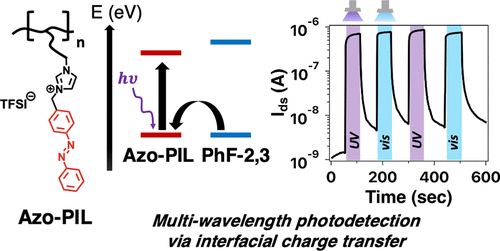当前位置:
X-MOL 学术
›
ACS Appl. Polym. Mater.
›
论文详情
Our official English website, www.x-mol.net, welcomes your feedback! (Note: you will need to create a separate account there.)
Multiwavelength Photodetectors Based on an Azobenzene Polymeric Ionic Liquid
ACS Applied Polymer Materials ( IF 5 ) Pub Date : 2021-09-14 , DOI: 10.1021/acsapm.1c00884 Angelique M. Scheuermann 1 , Hiba Wakidi 1 , Alexander T. Lill 1 , Saejin Oh 1 , Luana C. Llanes 1 , Colton A. D’Ambra 1 , Ségolène Antoine 2 , Ming Wang 3 , Michael L. Chabinyc 4 , Thuc-Quyen Nguyen 1, 5 , Javier Read de Alaniz 1, 2 , Christopher M. Bates 1, 2, 4, 6
ACS Applied Polymer Materials ( IF 5 ) Pub Date : 2021-09-14 , DOI: 10.1021/acsapm.1c00884 Angelique M. Scheuermann 1 , Hiba Wakidi 1 , Alexander T. Lill 1 , Saejin Oh 1 , Luana C. Llanes 1 , Colton A. D’Ambra 1 , Ségolène Antoine 2 , Ming Wang 3 , Michael L. Chabinyc 4 , Thuc-Quyen Nguyen 1, 5 , Javier Read de Alaniz 1, 2 , Christopher M. Bates 1, 2, 4, 6
Affiliation

|
Organic photodetectors (OPDs) are a promising class of light-detecting devices that can be created with simple fabrication techniques from a large variety of chemical building blocks. While molecular photoswitches are commonly used to modulate the properties of these devices through reversible isomerization or charge transfer, this responsive behavior is typically limited to a small range of wavelengths. Here, we report the characteristics of multiwavelength photodetectors using bilayers of a light-responsive azobenzene polymeric ionic liquid (PIL) in conjunction with the semiconducting polymer poly{(4,4-dihexadecyl-4H-cyclopenta[1,2-b:5,4-b′]dithiophene-2,6-diyl)-alt-(2,3-difluoro-1,4-phenylene)} (PhF-2,3). Both ultraviolet (UV) and visible light induce a 102–103 increase in current at a constant voltage within 10 s, which decays immediately when the light is turned off. This light-mediated performance is fatigue-resistant across multiple ON/OFF cycles and can be modulated with wavelengths far into the visible region (660 and 700 nm). Frontier energy level calculations of the light-induced charge carrier density indicate that this light-responsive increase in current is due to photoexcitation and a subsequent charge-transfer process between the azobenzene polymeric ionic liquid and the semiconducting polymer. In summary, the device described in this report exhibits sensing capabilities for multiple wavelengths of light corresponding with the azobenzene absorption profile.
中文翻译:

基于偶氮苯聚合物离子液体的多波长光电探测器
有机光电探测器 (OPD) 是一类很有前途的光探测设备,可以使用多种化学构件通过简单的制造技术制造出来。虽然分子光开关通常用于通过可逆异构化或电荷转移来调节这些器件的特性,但这种响应行为通常仅限于小范围的波长。在这里,我们报告了使用双层光响应偶氮苯聚合物离子液体 (PIL) 与半导体聚合物 poly{(4,4-dihexadecyl-4 H -cyclopenta [1,2- b :5] ) 的多波长光电探测器的特性,4- b ']dithiophene-2,6-diyl)- alt-(2,3-二氟-1,4-亚苯基)} (PhF-2,3)。紫外线 (UV) 和可见光都会引起 10 2 –10 3在 10 秒内以恒定电压增加电流,当灯关闭时电流立即衰减。这种光介导的性能在多个开/关循环中具有抗疲劳性,并且可以用远到可见光区域(660 和 700 nm)的波长进行调制。光诱导电荷载流子密度的前沿能级计算表明,电流的这种光响应性增加是由于光激发和偶氮苯聚合物离子液体和半导体聚合物之间的后续电荷转移过程。总之,本报告中描述的设备展示了对与偶氮苯吸收曲线相对应的多个波长的光的传感能力。
更新日期:2021-10-08
中文翻译:

基于偶氮苯聚合物离子液体的多波长光电探测器
有机光电探测器 (OPD) 是一类很有前途的光探测设备,可以使用多种化学构件通过简单的制造技术制造出来。虽然分子光开关通常用于通过可逆异构化或电荷转移来调节这些器件的特性,但这种响应行为通常仅限于小范围的波长。在这里,我们报告了使用双层光响应偶氮苯聚合物离子液体 (PIL) 与半导体聚合物 poly{(4,4-dihexadecyl-4 H -cyclopenta [1,2- b :5] ) 的多波长光电探测器的特性,4- b ']dithiophene-2,6-diyl)- alt-(2,3-二氟-1,4-亚苯基)} (PhF-2,3)。紫外线 (UV) 和可见光都会引起 10 2 –10 3在 10 秒内以恒定电压增加电流,当灯关闭时电流立即衰减。这种光介导的性能在多个开/关循环中具有抗疲劳性,并且可以用远到可见光区域(660 和 700 nm)的波长进行调制。光诱导电荷载流子密度的前沿能级计算表明,电流的这种光响应性增加是由于光激发和偶氮苯聚合物离子液体和半导体聚合物之间的后续电荷转移过程。总之,本报告中描述的设备展示了对与偶氮苯吸收曲线相对应的多个波长的光的传感能力。

























 京公网安备 11010802027423号
京公网安备 11010802027423号